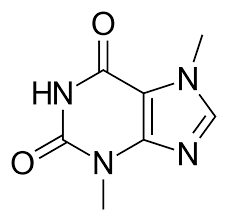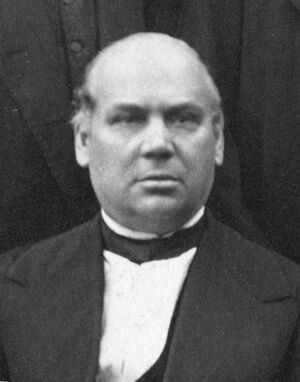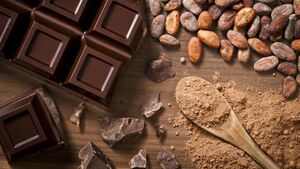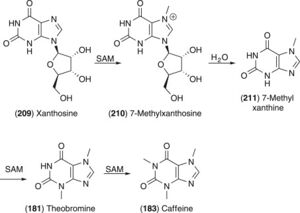Talk:Theobromine/2023
Theobromine (also known as xantheose) is a stimulant substance of the xanthine class.[1] Theobromine, also known as xantheose, is an alkaloid whose name is derived from the Theobroma family. It is the principal alkaloid of Theobroma cacao (cacao plant), tastes bitter, and has chemical formula C7H8N4O2. It is found in chocolate, as well as in a number of other foods, including the leaves of the tea plant, and the kola nut.
| Theobromine/2023 | |||||||||||||||||||||||||||||||||
|---|---|---|---|---|---|---|---|---|---|---|---|---|---|---|---|---|---|---|---|---|---|---|---|---|---|---|---|---|---|---|---|---|---|
| Chemical Nomenclature | |||||||||||||||||||||||||||||||||
| Common names | Theobromine | ||||||||||||||||||||||||||||||||
| Substitutive name | 3,7-dimethylxanthine | ||||||||||||||||||||||||||||||||
| Systematic name | 3,7-Dimethyl-3,7-dihydro-1H-purin-2,6-dion Name | ||||||||||||||||||||||||||||||||
| Class Membership | |||||||||||||||||||||||||||||||||
| Psychoactive class | Stimulant | ||||||||||||||||||||||||||||||||
| Chemical class | Xanthine | ||||||||||||||||||||||||||||||||
| Routes of Administration | |||||||||||||||||||||||||||||||||
|
|||||||||||||||||||||||||||||||||
https://www.ncbi.nlm.nih.gov/pmc/articles/PMC3672386/
http://www.chemspider.com/Chemical-Structure.5236.html 3,7-dimethylxanthine (also known as Theobromine) is a naturally-occurring stimulant substance of the xanthine class. Notable effects include stimulation, wakefulness, enhanced focus and motivation.
Discovery
Theobromine was first discovered in 1841 in cacao beans by Russian chemist Aleksandr Voskresensky. Synthesis of theobromine from xanthine was first reported in 1882 by Hermann Emil Fischer. Aleksandr Voskresensky
History
Chocolate has been prepared as a drink for nearly all of its history. For example, one vessel found at an Olmec archaeological site on the Gulf Coast of Veracruz, Mexico, dates chocolate's preparation by pre-Olmec peoples as early as 1750 BC. On the Pacific coast of Chiapas, Mexico, a Mokaya archaeological site provides evidence of cocoa beverages dating even earlier, to 1900 BC. The residues and the kind of vessel in which they were found indicate the initial use of cocoa was not simply as a beverage, but the white pulp around the cocoa beans was likely used as a source of fermentable sugars for an alcoholic drink.
Chocolate Mesoamerican usage Aztec. Man Carrying a Cacao Pod, 1440–1521. Volcanic stone, traces of red pigment. Brooklyn Museum An early Classic-period (460–480 AD) Maya tomb from the site in Rio Azul had vessels with the Maya glyph for cocoa on them with residue of a chocolate drink, suggests the Maya were drinking chocolate around 400 AD. Documents in Maya hieroglyphs stated chocolate was used for ceremonial purposes, in addition to everyday life. The Maya grew cacao trees in their backyards, and used the cocoa seeds the trees produced to make a frothy, bitter drink.
By the 15th century, the Aztecs had gained control of a large part of Mesoamerica and had adopted cocoa into their culture. They associated chocolate with Quetzalcoatl, who, according to one legend, was cast away by the other gods for sharing chocolate with humans, and identified its extrication from the pod with the removal of the human heart in sacrifice. In contrast to the Maya, who liked their chocolate warm, the Aztecs drank it cold, seasoning it with a broad variety of additives, including the petals of the Cymbopetalum penduliflorum tree, chile pepper, allspice, vanilla, and honey.
The Aztecs were unable to grow cocoa themselves, as their home in the Mexican highlands was unsuitable for it, so chocolate was a luxury imported into the empire. Those who lived in areas ruled by the Aztecs were required to offer cocoa seeds in payment of the tax they deemed "tribute". Cocoa beans were often used as currency. For example, the Aztecs used a system in which one turkey cost 100 cocoa beans and one fresh avocado was worth three beans.
The Maya and Aztecs associated cocoa with human sacrifice, and chocolate drinks specifically with sacrificial human blood. The Spanish royal chronicler Gonzalo Fernández de Oviedo y Valdés described a chocolate drink he had seen in Nicaragua in 1528, mixed with achiote: "because those people are fond of drinking human blood, to make this beverage seem like blood, they add a little achiote, so that it then turns red. ... and part of that foam is left on the lips and around the mouth, and when it is red for having achiote, it seems a horrific thing, because it seems like blood itself."
European Adaptation Until the 16th century, no European had ever heard of the popular drink from the Central American peoples. Christopher Columbus and his son Ferdinand encountered the cocoa bean on Columbus's fourth mission to the Americas on 15 August 1502, when he and his crew stole a large native canoe that proved to contain cocoa beans among other goods for trade. Spanish conquistador Hernán Cortés may have been the first European to encounter it, as the frothy drink was part of the after-dinner routine of Montezuma. José de Acosta, a Spanish Jesuit missionary who lived in Peru and then Mexico in the later 16th century, wrote of its growing influence on the Spaniards:
Although bananas are more profitable, cocoa is more highly esteemed in Mexico. . . Cocoa is a smaller fruit than almonds and thicker, which toasted do not taste bad. It is so prized among the Indians and even among Spaniards. . . because since it is a dried fruit it can be stored for a long time without deterioration, and they brings ships loaded with them from the province of Guatemala. . . It also serves as currency, because with five cocoas you can buy one thing, with thirty another, and with a hundred something else, without there being contradiction; and they give these cocoas as alms to the poor who beg for them. The principal product of this cocoa is a concoction which they make that they call “chocolate,” which is a crazy thing treasured in that land, and those who are not accustomed are disgusted by it, because it has a foam on top and a bubbling like that of feces, which certainly takes a lot to put up with. Anyway, it is the prized beverage which the Indians offer to nobles who come to or pass through their lands; and the Spaniards, especially Spanish women born in those lands die for black chocolate. This aforementioned chocolate is said to the be made in various forms and temperaments, hot, cold, and lukewarm. They are wont to use spices and much chili; they also make it into a paste, and it is said that it is a medicine to treat coughs, the stomach, and colds. Whatever may be the case, in fact those who have not been reared on this opinion are not appetized by it.
Chemistry
Theobromine belongs to a class of substances called xanthines Theobromine is a slightly water-soluble (330 mg/L), crystalline, bitter powder. Theobromine is white or colourless, but commercial samples can be yellowish. It has an effect similar to, but lesser than, that of caffeine in the human nervous system, making it a lesser homologue. Theobromine is an isomer of theophylline, as well as paraxanthine. Theobromine is categorized as a dimethyl xanthine. Theobromine has an elimination half-life of 7.1±0.7 hours
Pharmacology
The principal mechanism of action of theobromine is as a nonselective antagonist at the adenosine A1 and A2A receptors. During waking periods, the brain levels of the neurotransmitter adenosine steadily increase and trigger fatigue and sleepiness. The theobromine molecule is structurally similar to adenosine, which enables it to bind to adenosine receptors on the surface of cells without activating them, thereby acting as a competitive inhibitor.
Theobromine vs. Caffeine
Source Theobromine and caffeine are similarly constructed types of pharmacologically active chemicals but with noticeably different effects. Theobromine is gentle, mild, has a slow onset, is long lasting and non-addictive whereas caffeine is intense, strong, fast acting, short lived and can be addictive.
Subjective Effects
|
Physical effects 
-
- Stimulation - Theobromine is reported to be mildly to moderately energetic and stimulating in a fashion that is considerably weaker in comparison to that of traditional recreational stimulants such as amphetamine, MDMA or cocaine. This encourages physical activities such as performing chores and repetitive tasks which would otherwise be boring and strenuous physical activities. The particular style of stimulation which theobromine presents can be described as forced. This means that at higher dosages, it becomes difficult or impossible to keep still as jaw clenching, involuntarily bodily shakes and vibrations become present, resulting in extreme shaking of the entire body, unsteadiness of the hands, and a general lack of motor control.
- Physical euphoria - Theobromine has been reported to produce very mild physical euphoria in non-tolerant users, especially when they are already well-rested. [citation needed]
- Appetite suppression[citation needed]
- Bronchodilation - Theobromine is a bronchodilator. [citation needed]
- Dizziness - This effect is not common except at overly high doses or taken when fatigued or at low blood sugar. [citation needed]
- Frequent urination [citation needed]
- Headaches and Headache suppression - Theobromine can suppress headaches at light and common dosages, but may cause headaches at higher ones. This is likely due to its vasoconstricting and a vasodilating effects. [citation needed]
- Increased blood pressure
- Increased heart rate
- Increased perspiration
- Nausea - Moderate to extreme nausea has been reported to occur, typically at higher dosages. [citation needed]
- Stamina enhancement - This effect is relatively mild compared to other stimulants such as amphetamine.
- Tactile enhancement
- Teeth grinding - This effect does not occur as consistently as it does on other stimulants such as amphetamine or MDMA.
- Vasoconstriction
|
Cognitive effects 
-
Although negative side effects are usually mild at low to moderate dosages, they become increasingly likely to manifest themselves with higher amounts or extended usage. This particularly holds true during the offset of the experience. An individual’s caffeine tolerance can also greatly compromise the strength of effect for theobromine since they both antagonize the same receptor subtype. The overall headspace is considered to be smoother, less ‘scatterbrained’, more euphoric and more empathetic compared to caffeine.
The most prominent of these cognitive effects generally include:
- Analysis enhancement
- Anxiety - Unlike caffeine, this component is usually only present during the onset but can actually be more intense when it does occur.
- Cognitive euphoria - This effect, although generally mild compared to most stimulants, is considered to be qualitatively more pleasurable and much long-lasting than with caffeine. It usually only occurs in those with low tolerance.
- Cognitive dysphoria - This effect typically only occurs at high to extremely high dosages.
- Focus enhancement - This component is most effective at low to moderate dosages as anything higher will usually impair concentration.
- Increased libido
- Increased music appreciation - While theobromine is capable of producing this effect, it does not do so as reliably as it does with traditional stimulants or entactogens.
- Empathy, affection and sociability enhancement - Even though theobromine is quite similar quantitatively in its level of strength and largely even its subjective flavor to caffeine, theobromine’s more palpable; albeit relatively subdued empathogenic qualities serves as the most significant and noticeable qualitative contrast between the two. In many ways, theobromine can essentially be thought of as “entactogenic caffeine”.
- Memory enhancement
- Motivation enhancement
- Thought acceleration This effect tends to feel less ‘speedy’ than caffeine, even when the caffeine is consumed through tea.
- Wakefulness
After effects 
- The effects which occur during the offset of a stimulant experience generally feel negative and uncomfortable in comparison to the effects which occurred during its peak. Theobromine blocks adenosine receptors, which causes a build up of adenosine during its peak. During the offset experience, the built up adenosine activates the previously blocked receptors with a much higher strength than they would normally, causing a number of unpleasant effects. This is often referred to as a "comedown". The comedown experienced with theobromine is usually less intense than the comedown experienced with dopaminergic stimulants such as amphetamine and cocaine. Its effects commonly include:
}}
Image citations
Aleksandr Voskresensky. (n.d.). [Photograph]. Https://En.Wikipedia.Org/Wiki/Aleksandr_Voskresensky. 
Cocoa. (n.d.). [Photograph]. Https://Www.History.Com/News/the-Sweet-History-of-Chocolate. 
 . (n.d.). [Photograph]. Https://Www.Sciencedirect.Com/Topics/Nursing-and-Health-Professions/Xanthine-Derivative.
. (n.d.). [Photograph]. Https://Www.Sciencedirect.Com/Topics/Nursing-and-Health-Professions/Xanthine-Derivative. 
- ↑ "Theobromine". Wikipedia.



